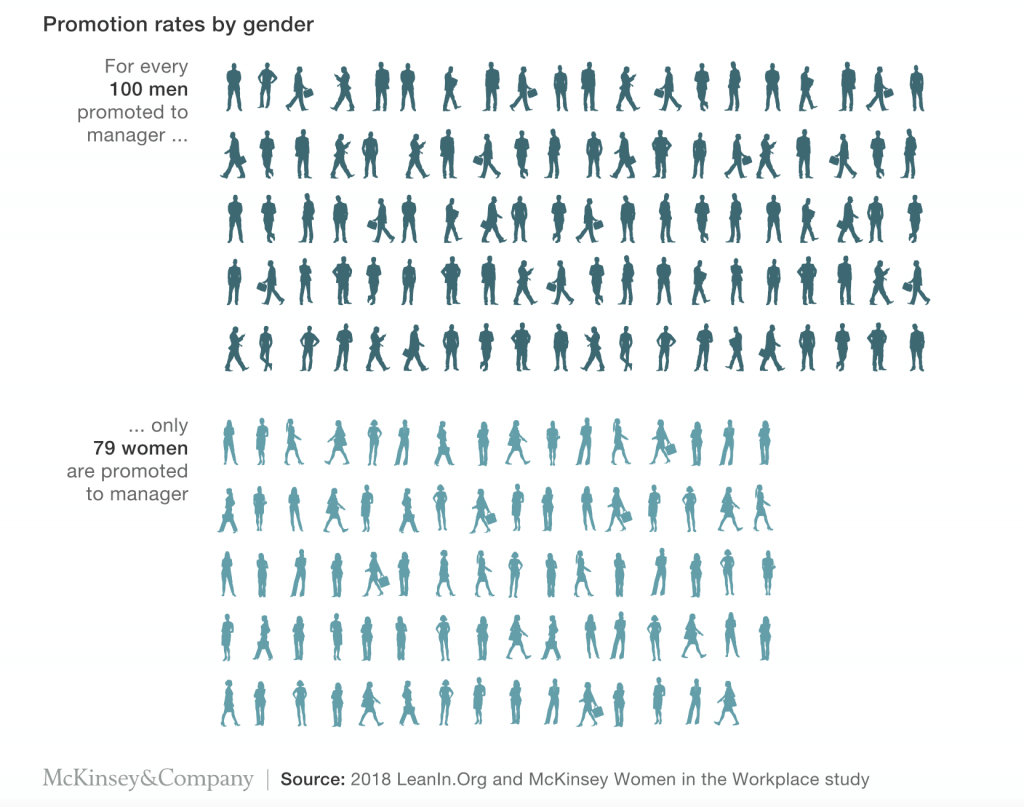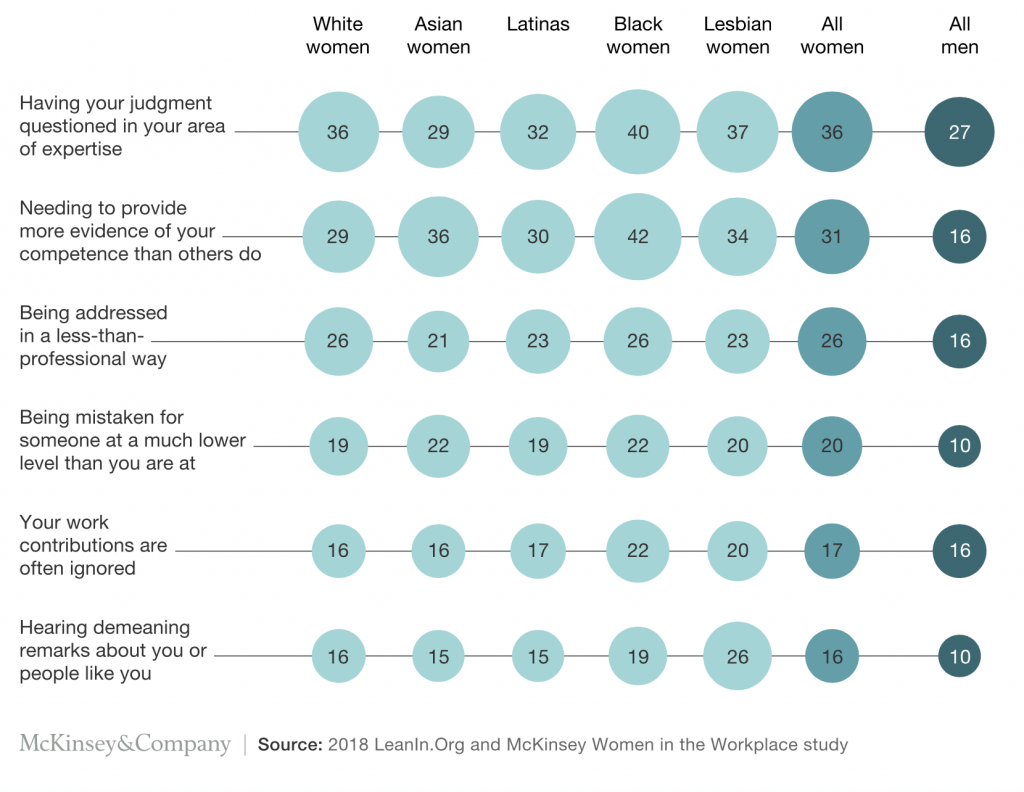Recently I’ve been thinking a lot about the equality and different biases in our society. Being a woman, I have faced some biases and discrimination myself, especially in the workplace. Moreover, I’ve seen sexism and gender discrimination related towards my female friends. It resulted in my deeper interest in this topic and today, before sharing my personal experience in this blog, I want to discuss transformation of the women’s role during the last decades and the influence of gender biases on women’s lives.
What Is a Gender Stereotype and How Has It Emerged?
The last century saw a huge transformation and movement for equal rights between men and women. Nowadays, the equality of people, regardless of their gender, lies in the workplace, family, and voting laws in many countries. However, despite all the achievements women’s movements have brought, gender parity remains a far-off goal.
To begin with, let’s have a look at what gender stereotypes are and why these stereotypes create discrimination and inequality in our society.
A gender stereotype is a generalized view or bias about attributes or characteristics, or the roles that are or ought to be owned by women and men. A gender stereotype is harmful when it limits women’s and men’s ability to develop their personal abilities, pursue their professional careers and make choices about their lives. ¹
Gender stereotypes usually result in the discrimination against women and violation of their rights, when talking about education, career, freedom of expression and movement, etc.
How Was a Woman’s Image in the Workplace Created?
Gender biases and discrimination resulted into the certain image of the role of women not only at home, but also at the workplace. For centuries men were seen as the main workers in the family and their economical role was more valued. As a result, economically valued positions with higher wages were predominated by men. Due to gender stereotypes and biases, males in power were more likely to hire and promote other men.
It is a fact that even if men and women were doing the same job, men make more money in their career than women, even if they hold the same position. It was more difficult for women to find a good job, build a successful career and work at managerial positions.
Nowadays, the so-called glass ceiling is cracking, however gender parity is still out of reach.
The representation of women in senior level positions remains low.

The chances for women to be promoted to managerial positions are lower than for men.

The statistics show that women are also treated differently in the workplace than men.

The Reasons for Gender Bias in the Workplace
Long history of gender discrimination and biases along with social beliefs about different traits of men and women are the main reasons for inequality at the workplace. Since men are usually seen to be decisive and strong, they are seen as good leaders. Women, on the other hand, are believed to be more caring and sympathetic, but at the same time more emotional and less logical. These stereotypes lead to discrimination against women.
I can’t say that I’ve been facing a lot of discrimination during my life, but I have had some experience with gender biases and the glass ceiling in the workplace.
My Personal Story
Being a young professional with several years of experience in a marketing field, I was planning to build a career of my dream. Since at my current workplace there was no more room to progress, I decided to move forward and consider other companies with the opportunities for career growth. I was lucky enough to be interviewed by the HR manager and Head of marketing 2 weeks later for the VP of marketing position in a bank.
The company had 2 open positions – Marketing Manager and a VP of Marketing. And although I applied for VP of marketing, I was offered the Marketing Manager position. What overwhelmed me here was the reason for this. I was told by the Head of Marketing that another candidate applied for a marketing manager position and he’d like him to become a VP of marketing. Although I had more experience and was a more suitable candidate, he prefers to work more closely with another man rather than a woman.
I felt frustrated and humiliated, thinking that this is my fault, trying to analyze if I’ve done anything wrong. I was young and didn’t realize that the problem lies in the gender biases and sexism, and that this is illegal.
Although I was lucky enough to find another job and build a career in marketing that I’m proud of, that situation made me less confident and more vulnerable.
Steps to Overcome the Gender Bias
As mentioned before, a lot of progress was made in the gender equality field to provide men and women with equal rights. Still, it won’t be true to say that both genders always have equal chances for success. So, what can be done to overcome gender bias and create a world with equal opportunities.
Grow Awareness
The first step to take is to admit that the problem still exists. We should realize that probably each of us lives with some biases, so the task is to notice them when they arise and understand how they are affecting our actions. If you’d like to find out more about your own gender, racial and other forms of stereotypes you can also take the Implicit Association Test, provided by Harvard University – https://implicit.harvard.edu/implicit/takeatest.html
Change Your Attitude
Trying to accept both genders in counter-stereotypical roles will help to break the gender stereotypes and allow all members of our society to freely manifest themselves.
Educate Others
Try not only to change your personal attitude, but also help the organization you work for to reduce gender biases. You can act as a thought leader and have conversations about discrimination history and importance of gender balance for the business success. Provide your HR leaders with useful information, help them to ensure that they consider gender balance when shortlisting candidates, etc.
Summing Up
It’s important to acknowledge that we are all part of the problem, either consciously or unconsciously we are living within our stereotypes. To realize this and to take corrective action is something that can help to create a better word with equal opportunities for ourselves and our posterity.
References
- https://www.ohchr.org/EN/Issues/Women/WRGS/Pages/WrongfulGenderStereotyping.aspx
- https://www.mckinsey.com/featured-insights/gender-equality/women-in-the-workplace-2019
- https://www.mckinsey.com/featured-insights/gender-equality/women-in-the-workplace-2018



